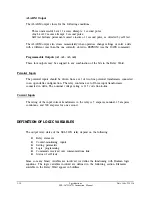
The fault type is determined largely independently of the relay element operations. Only the
indicated zone is determined by relay elements, whereas the involved phases are determined
by fault current comparison. (This is different from the TARGET data, which is completely
derived from relay element operations.)
The compared currents are taken from the two rows at the middle of the stored fault data. If
the uncompensated current magnitudes are in large ratios between phases (4:1 or more), then
the fault type becomes immediately apparent as single- or two-phase. If not, the same current
is load compensated by the two corresponding prefault current rows in the first cycle of the
event report. If these fault current component magnitudes are in moderate ratios (1.5:1 or
more), then the fault type is taken as single- or two-phase, or if the ratios are all less than
1.5, then the fault type is taken as three-phase. The explicit fault classification logic is as
follows, where
"
I
"
values are uncompensated midfault currents, and
"
If
"
values are midfault
currents compensated for load, yielding true fault current components:
IF
(Imax > 4 x Imed)
THEN Single-phase
ELSE IF
(Imed > 4 x Imin)
THEN Two-phase
ELSE IF
(Ifmax > 1.5 x Ifmed)
THEN Single-phase
ELSE IF
(Ifmed > 1.5 x Ifmin)
THEN Two-phase
ELSE IF
(none of the above)
THEN Three-phase.
This algorithm is largely immune to load and system grounding variations.
Once the fault type is determined, the fault locator employs the Takagi algorithm to locate the
fault. Using both prefault and fault data, it compensates for the errors introduced by fault
resistance in the presence of load flow. On the other hand, if no prefault data are provided
by the event record, the SEL-267D relay gives a location based on a simple reactance
measurement.
You can set the relay to use a ground fault locating algorithm slightly modified for use on
radial lines by setting LOCAT=R. With LOCAT=R the relay can compensate for shunt load
measured during a ground fault. Note that this is most effective if there are no zero-sequence
current sources forward from the relay location. If there are ground sources in front of the
relay, set LOCAT=L to select standard looped system fault locating.
The fault locator depends on accurate transmission line parameters and instrument transformer
ratios. Pay special attention to these potential sources of difficulty:
Instrument transformer ratio errors due to overburden by other devices
Capacitive potential transformer capacitor value
Transmission line parameter errors
Date Code 920326
Specifications
SEL-267D/167D Instruction Manual
2-23
Summary of Contents for SEL-167D
Page 3: ......
Page 6: ......
Page 8: ......
Page 9: ......
Page 10: ......
Page 11: ......
Page 51: ...LOGIC DIAGRAMS Date Code 920326 Specifications SEL 267D 167D Instruction Manual 2 31 ...
Page 52: ...Date Code 920326 Specifications 2 32 SEL 267D 167D Instruction Manual ...
Page 53: ...Date Code 920326 Specifications SEL 267D 167D Instruction Manual 2 33 ...
Page 54: ...Date Code 920326 Specifications SEL 267D 167D Instruction Manual 2 34 ...
Page 88: ...SAMPLE EVENT REPORT ...
Page 114: ......
Page 115: ......
















































